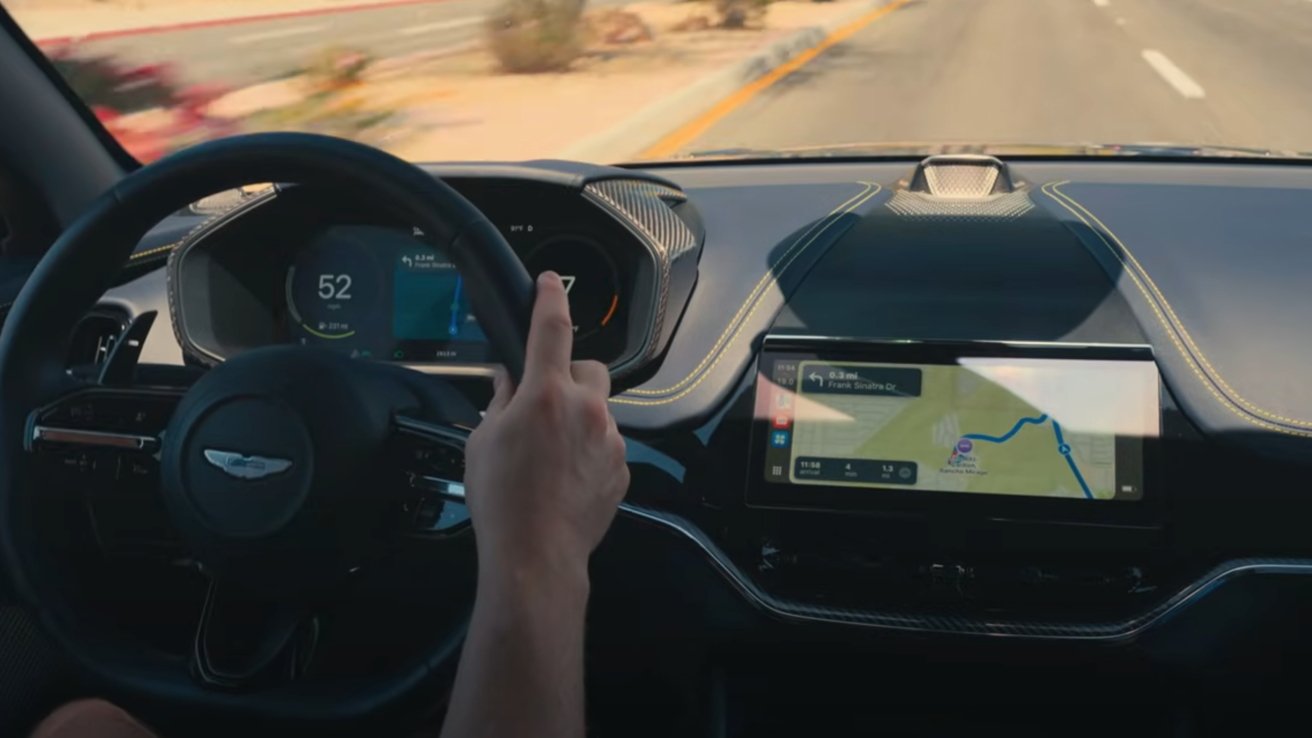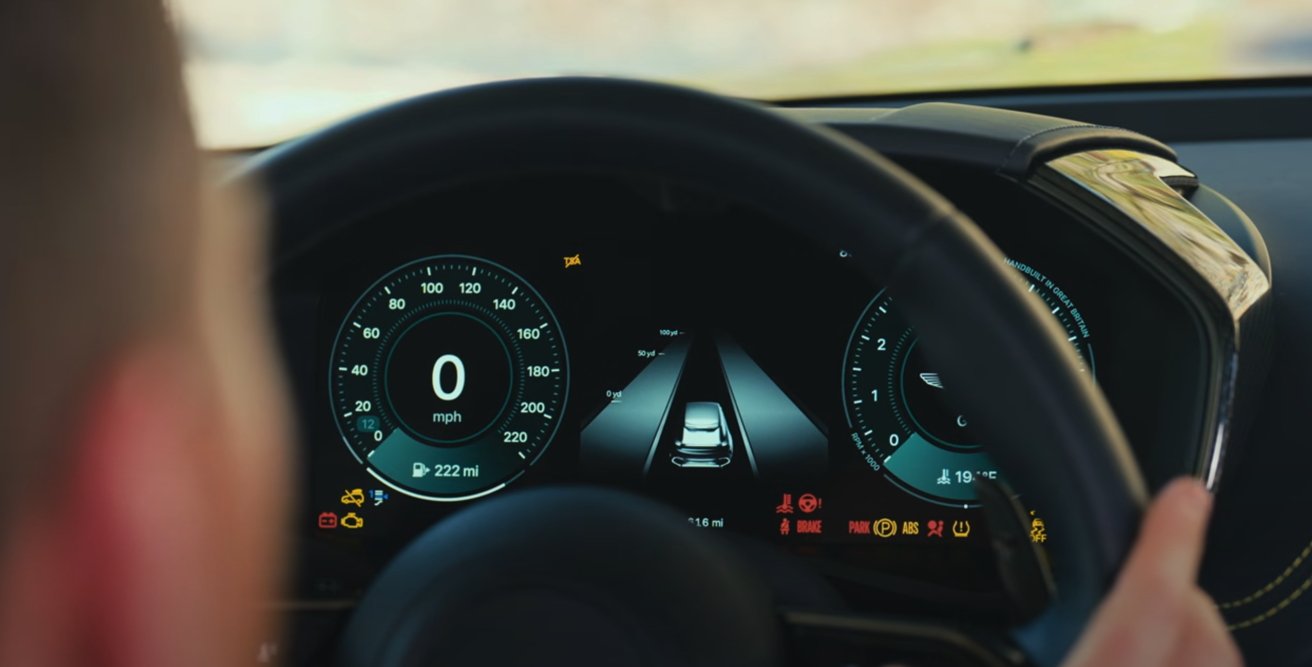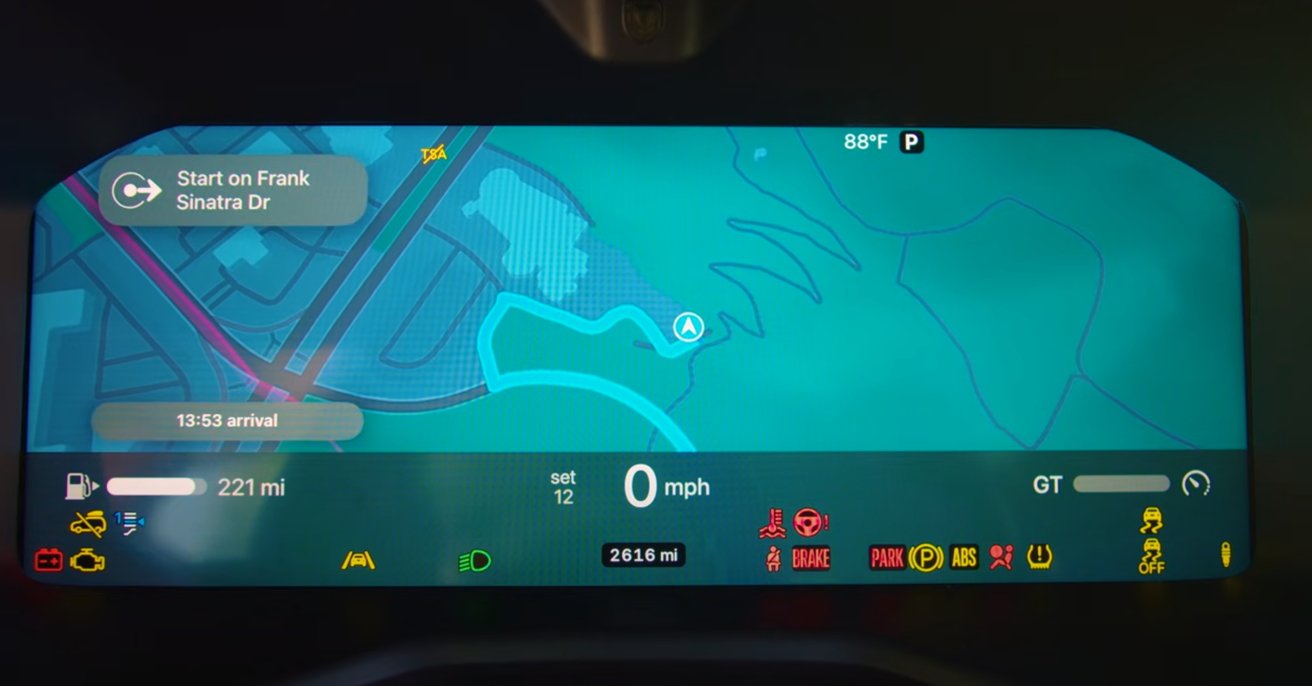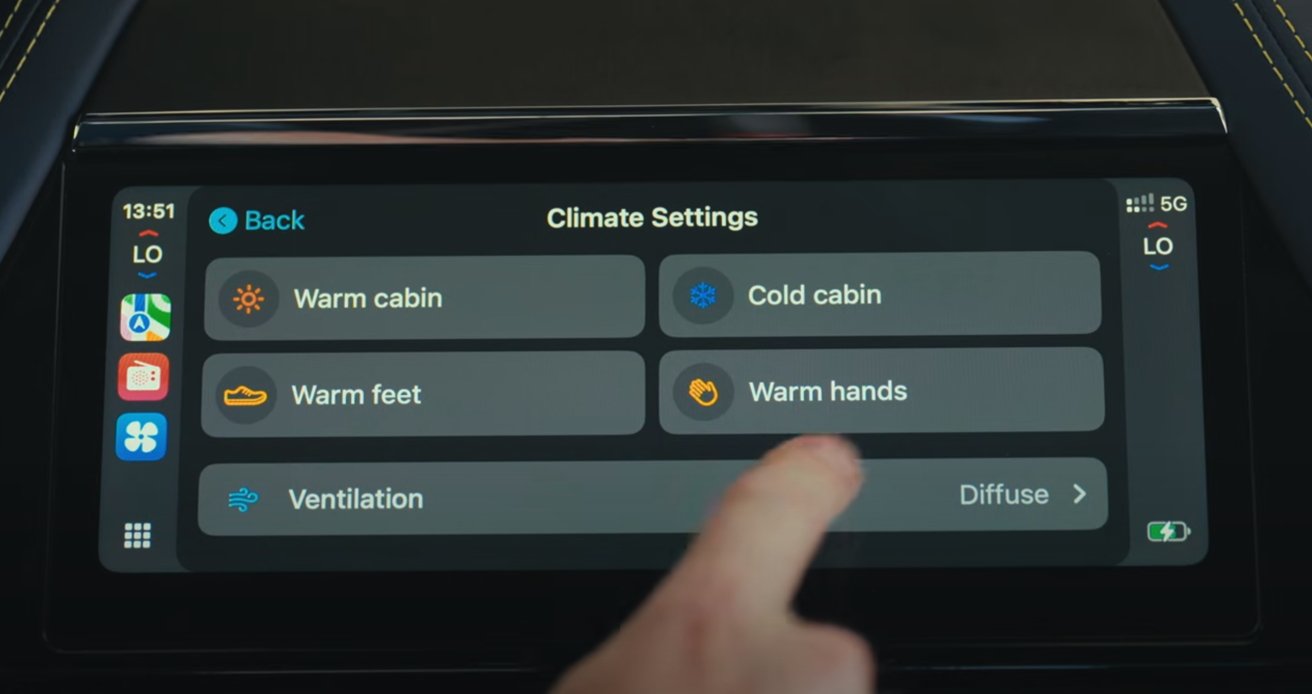CarPlay Ultra's first trial reveals a deeply integrated, Apple-like experience
The first trial of CarPlay Ultra in an Aston Martin has deemed Apple's in-car upgrade a massive success, even if car manufacturers will be wary of handing over the UI reins.

CarPlay Ultra in an Aston Martin - Image Credit: Top Gear/YouTube
On Thursday, Apple finally made CarPlay Ultra available to use. Shipping initially in the Aston Martin, the next-generation interface expands the iPhone-based interface across multiple displays on the dashboard, and promises a more cohesive experience for drivers.
In an initial try-out of CarPlay Ultra in a YouTube video, Top Gear explores the new expanded interface, as well as the challenges it faces.
Appeasing manufacturers
One of the first topics brought up in the video is car manufacturer personalization and control. Not all manufacturers are keen on using the new CarPlay, due to the way it dominates all of the available screens, including the instrument panel.
Ola Kallenius, CEO of Mercedes-Benz AG, went on record to dismiss the idea of another company having control over all of the screens in the company's cars.
This resistance has led to Apple working to make CarPlay Ultra as acceptable as possible, by offering as much customization as possible.
Apple's implementation is to provide a set of templates, so that the manufacturers can tailor how the various elements of the interfaces appear within CarPlay Ultra itself. This also takes into account the varying needs of different vehicle designs, such as size and quantity of screens, whether they are electric or fuel-based, and other needs.
A big integration change
CarPlay Ultra is more than just using the interface on an increasing number of displays in a vehicle. While normal CarPlay is largely a way to access iPhone functions on an infotainment system, CarPlay Ultra goes a lot further.
Some of the elements are still iPhone-hosted services as before, but now it incorporates data points and controls sourced from the car itself, referred to as "local UI." Elements such as speed and fuel level are incorporated into Apple's interface, which is then shown to the driver.

The standard CarPlay Ultra instrument view - Image Credit: Top Gear/YouTube
On top of that is "punch-through UI," which refers to some elements from the car's native infotainment system to work directly, with minimal interference from CarPlay itself. This can take the form of things such as a car's reversing camera, handled by the onboard system but displayed within CarPlay itself without extra elements.
Wireless and updated
As part of the improved interface, Apple also upgraded how CarPlay itself interfaces with the iPhone itself.
To get the new CarPlay Ultra working, you need an iPhone 12 or later, running on iOS 18.4 or newer. Furthermore, while earlier CarPlay could use wired and wireless connections with the iPhone depending on the setup, CarPlay Ultra works entirely wirelessly by default.
Even so, there's still the option of using a wire if you really want. It is offered in the video that the connection and setup is a little quicker with the physical connection, too.
Getting started for the first time, users are offered the option to set up CarPlay on their iPhone, which then leads to a "Setting Up CarPlay" graphic for a brief period. The car's interface then asks users to agree to terms and conditions.
This is only performed for the first interaction of the iPhone with the vehicle. Subsequent times, the system connects and runs automatically.
The booting process prioritizes the instrument panel display first, so that the driver can actually use the vehicle, even if other CarPlay Ultra elements take a little longer to get going.
Instrument cluster
The version of the instrument panel shown in the video is customized to look how it would typically look in a non-CarPlay Ultra manner. Aston Martin branding is shown alongside hints of dark green, with analog speed and rev counters on the left and right sides.
In between the dials is an "info square," which can switch between different functions. Swiping using an on-wheel control, the driver could switch to Apple Maps or control Apple Music, or view car-specific data like tyre pressures.

CarPlay Ultra's expanded instrument cluster view - Image Credit: Top Gear/YouTube
This is the default layout, but drivers can also switch between a few options on the fly. This includes altering the visual style without changing item placement for a few of them.
However, one layout expands the info square to fill almost the entire panel. At the base of the screen essential elements such as indicators, fuel level, and speed are shown on a translucent strip, so that data is always in view.
Central screen
The main infotainment screen doesn't seem to have changed that much at first glance. Existing CarPlay users will be familiar with how it works and appears, but changes can quickly become apparent.
While users would previously need to exit CarPlay to view the native interface to make changes to in-car features, like air conditioning, they don't have to anymore. With local UI in use, the in-car functions now appear within CarPlay, without needing to exit it.
Again, these elements are specific to the manufacturer and the car, and can be personalized. The video demonstrates this by showing air conditioning zone selections in the interface, which would vary between manufacturers.
All of the controls here are said to "feel very Apple" in how they appear and function. Even with the manufacturer changes.

Climate settings in CarPlay Ultra - Image Credit: Top Gear/YouTube
It was noted that the interface does take into account the user's iPhone settings when setting up CarPlay. Noticing that the iPhone was set to British English, the interface is shown using British spellings, including the "u" where necessary, and temperatures from Fahrenheit to Celsius.
Vehicle settings are also shown, including ways to set the exhaust noise, steering, suspension stiffness, and other core configurable elements.
When selecting to adjust the Bowers & Wilkins audio system, CarPlay uses the punch-through UI to show the native interface for that feature. It's exactly the same view as you would see in the native UI, except with CarPlay elements to the sides.
Swipes to the display bring up other views, including panels for navigation, and also a widgets screen.
Users can also customize the appearance of CarPlay from the screen, with various themes that are, again, described as having an Apple feel to them. This can also affect the instrument cluster, dramatically changing its appearance from what a person may normally see.
An exciting development
In summing up the experience, CarPlay Ultra is considered to be an exciting change for drivers and passengers. Apple's mastery at getting software to be simple to use is a considerable strength here, especially over typical in-car interfaces by car producers.
Existing CarPlay users will easily adopt the new version, but it is also believed that newcomers will also use it too. The one-time setup makes it a no-brainer for consumers to use.
The slickness, integration, and Apple familiarity are plus points for an interface, something car manufacturers frequently struggle to get right.
Read on AppleInsider


Comments
Before watching the video I hadn't realized that this Car Play Ultra is essentially an SDK for car makers to design their own screens (with a ton of pre-built stuff Apple provides). It's not Apple designing the interface for a particular manufacturer (although it's clear from the interview that in the A-M case it was a joint design effort).
Also, it's cool that owners of late model A-Ms will be able to get upgrades to add Apple Play Ultra retroactively.
Multiple choice quiz: Car manufacturers are a) clueless about UI design, b) unmotivated, c) lazy, d) cheap, e) all of the above. I can understand why they are leery of handing over too much control to Apple, but it seems Apple's SDK is cooperative rather than absolute.
The key thing is that CarPlay Ultra will get better and better. You're not just stuck with the same interface options for ever.
Very cool.
How much is an Aston Martin again?
as for android more generally, they are doing similar but more forked versions that the manufacturers build I think. Like GM is doing.
But otherwise, that CarPlay ultra is awesome. Be interesting to see once Hyundai makes it available for the ordinary punters, and will Hyundai backdate it to the digital instrument panel and HUD on my 2021 Santa Fe?
CarPlay supports the Apple 'ecosystem.' In a nutshell, it helps sell iPhones. Having maps, music and other applications seamlessly follow you into your car makes the iPhone a more desirable device.
Making an Apple Car not only cuts that off, it actually undermines it. The day Apple announces that it will be producing an Apple Car is the day that every other car manufacturer decides to drop CarPlay. No carmaker is going to provide dashboard real estate to a direct competitor. Cars are the first or second most expensive possession for most people. When, as is the case now, there are literally hundreds of options for cars that include CarPlay, that feature can be a first pass filter in selecting a car. This in turn motivates more car brands to include the feature.
If, on the other hand, that changes to only one option - chose an Apple car to go with your iPhone or choose literally any other car- compatibility with your iPhone becomes a much, much lower priority. Then everyone who doesn't choose an Apple car is motivated to also get a different brand phone that actually is compatible with their car. So with that calculus, there isn't going to be a resurrected Apple car in the foreseeable future.
I'm sure soon we'll hear about an "Android Auto Ultra" option. If and when that happens, auto manufacturers will feel even more pressured to adopt the tech like they did when CarPlay was released.
I personally don't feel like it's a good idea for Apple to make a car. They had the opportunity to buy Tesla and booting Elon but made the decision to ignore him and his offer. If there's any discussion for Apple to get into the car business I hope they'd consider Lucid, their EV tech second to none or maybe BYD (I'm sure BYD is not for sale). You gotta think, in what price range will the Apple car be, I would think it'll either be out of many people's price range (aka $100k+) or as affordable as a Fiat 500 or a Mini Cooper.
/s
My question is about other people riding the configured car …
Will it be back to factory settings when turned off ?
Will the settings be saved in the car? Or, in the phone?
Current CarPlay saves the settings, and I guess, it recognizes the user when he/she reconnects.
That’s about rental cars …
If one doesn’t want to use the new CP Ultra can he/she still use the old CarPlay ?
Car... it would make sense. We spend a lot on cars and it is lifestyle, the need for financing could make sense to Apple, a lot of services from insurance to features to get a cut from, and Apple should have been able to deliver autonomous driving in at least some locations simply by throwing everything at R&D. Profit margins are lower but revenue is high. And it is a market ready for disruption.
It’s undeniably sexy, but is the PR worth the resources required to develop and support?